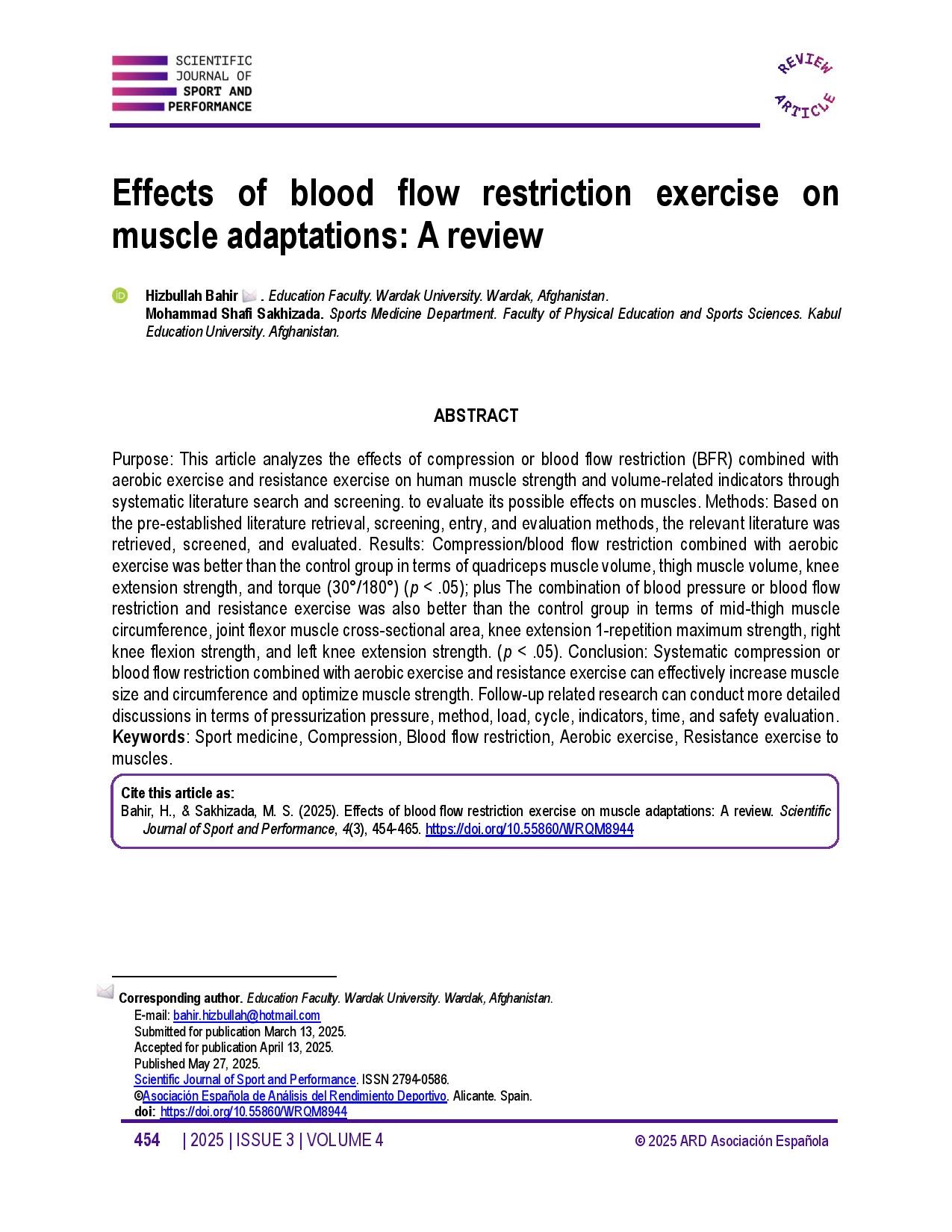Effects of blood flow restriction exercise on muscle adaptations A review
Main Article Content
Abstract
Purpose: This article analyzes the effects of compression or blood flow restriction (BFR) combined with aerobic exercise and resistance exercise on human muscle strength and volume-related indicators through systematic literature search and screening. to evaluate its possible effects on muscles. Methods: Based on the pre-established literature retrieval, screening, entry, and evaluation methods, the relevant literature was retrieved, screened, and evaluated. Results: Compression/blood flow restriction combined with aerobic exercise was better than the control group in terms of quadriceps muscle volume, thigh muscle volume, knee extension strength, and torque (30°/180°) (p < .05); plus The combination of blood pressure or blood flow restriction and resistance exercise was also better than the control group in terms of mid-thigh muscle circumference, joint flexor muscle cross-sectional area, knee extension 1-repetition maximum strength, right knee flexion strength, and left knee extension strength. (p < .05). Conclusion: Systematic compression or blood flow restriction combined with aerobic exercise and resistance exercise can effectively increase muscle size and circumference and optimize muscle strength. Follow-up related research can conduct more detailed discussions in terms of pressurization pressure, method, load, cycle, indicators, time, and safety evaluation.
Article Details

This work is licensed under a Creative Commons Attribution-NonCommercial-ShareAlike 4.0 International License.
References
Ajmiri, M. Y., & Bahir, H. (2023). Impact of Physical Exercise on the Mental Health of the Elderly. Sustainability and Sports Science Journal, 1(2), 46-52. https://doi.org/10.61486/ETCK4342 DOI: https://doi.org/10.61486/ETCK4342
An, F. P., Balantekin, A. B., Band, H. R., Bishai, M., Blyth, S., Butorov, I., Cao, D., Cao, G. F., Cao, J., Cen, W. R., Chan, Y. L., Chang, J. F., Chang, L. C., Chang, Y., Chen, H. S., Chen, Q. Y., Chen, S. M., Chen, Y. X., Chen, Y., … Zou, J. H. (2016). Measurement of the reactor antineutrino flux and spectrum at Daya Bay. Physical Review Letters, 116(6). https://doi.org/10.1103/PhysRevLett.116.061801 DOI: https://doi.org/10.1103/PhysRevLett.116.061801
Bautmans, I., Van Hees, E., Lemper, J. C., & Mets, T. (2005). The feasibility of whole body vibration in institutionalised elderly persons and its influence on muscle performance, balance and mobility: A randomised controlled trial [ISRCTN62535013]. BMC Geriatrics, 5, 1-8. https://doi.org/10.1186/1471-2318-5-17 DOI: https://doi.org/10.1186/1471-2318-5-17
Clayton, D. J., Barutcu, A., Machin, C., Stensel, D. J., & James, L. J. (2015). Effect of Breakfast Omission on Energy Intake and Evening Exercise Performance. Medicine and Science in Sports and Exercise, 47(12), 2645-2652. https://doi.org/10.1249/MSS.0000000000000702 DOI: https://doi.org/10.1249/MSS.0000000000000702
Da Silva, R. P., Martinez, D., Faria, C. C., De Carli, L. A., De Souza, W. I. B. P., Meinhardt, N. G., Souto, K. E. P., Trindade, M. R. M., & Ribeiro, J. P. (2013). Improvement of exercise capacity and peripheral metaboreflex after bariatric surgery. Obesity Surgery, 23(11), 1835-1841. https://doi.org/10.1007/s11695-013-0988-x DOI: https://doi.org/10.1007/s11695-013-0988-x
Edwards, N. C. (2006). School Facılıtıes And Student Achıevement: Student Perspectıves On The Connectıon Between The Urban Learnıng Envıronment And Student Motıvatıon And Performance. In Global Shadows: Africa in the Neoliberal World Order (Vol. 44, Issue 1959).
Genelhu, V. A., Celoria, B. M. J., Duarte, S. F. P., Cabello, P. H., & Francischetti, E. A. (2009). Not all obese subjects of multiethnic origin are at similar risk for developing hypertension and type 2 diabetes. European Journal of Internal Medicine, 20(3), 289-295. https://doi.org/10.1016/j.ejim.2008.09.009 DOI: https://doi.org/10.1016/j.ejim.2008.09.009
Hazim, H., Zalmai, M. R., & Bahir, H. (2024). Exploring the Impact of Nutrition and Physical Activity on Human Metabolism. Sprin Journal of Arts, Humanities and Social Sciences, 3(4), 39-42. https://doi.org/10.55559/sjahss.v3i4.284 DOI: https://doi.org/10.55559/sjahss.v3i4.284
Kanis, J. A., Delmas, P., Burckhardt, P., Cooper, C., & Torgerson, D. (1997). Guidelines for diagnosis and management of osteoporosis. Osteoporosis International, 7(4), 390-406. https://doi.org/10.1007/BF01623782 DOI: https://doi.org/10.1007/BF01623782
Kraemer, W. J., Ratamess, N. A., & French, D. N. (2002). Resistance training for health and performance. In Current sports medicine reports (Vol. 1, Issue 3, pp. 165-171). https://doi.org/10.1249/00149619-200206000-00007 DOI: https://doi.org/10.1249/00149619-200206000-00007
Lin, X., & Sharifi, K. D. (2021). The Entire Body Quiver Effect on Lower Extremity Flexibility in Healthy Young Female. OALib, 08(10), 1-11. https://doi.org/10.4236/oalib.1107953 DOI: https://doi.org/10.4236/oalib.1107953
Marcon, E. R., Gus, I., & Neumann, C. R. (2011). Impacto de um programa mínimo de exercícios físicos supervisionados no risco cardiometabólico de pacientes com obesidade mórbida. Arquivos Brasileiros de Endocrinologia & Metabologia, 55(5), 331-338. https://doi.org/10.1590/S0004-27302011000500006 DOI: https://doi.org/10.1590/S0004-27302011000500006
Orsega-Smith, E. M., Payne, L. L., Mowen, A. J., Ho, C. H., & Godbey, G. C. (2007). The role of social support and self-efficacy in shaping the leisure time physical activity of older adults. Journal of Leisure Research, 39(4), 705-727. https://doi.org/10.1080/00222216.2007.11950129 DOI: https://doi.org/10.1080/00222216.2007.11950129
Pantović, M., Madić, D., Popović, B., Batez, M., & Obradović, J. (2015). Efekti primene vibracionog treninga i treninga sa dodatnim spoljašnjim opterećenjem na razvoj snage kod 13-godišnjeg dečaka nakon lezije m. biceps femoris i posttraumatske kalcifikacije. Vojnosanitetski Pregled, 72(7), 646-650. https://doi.org/10.2298/VSP140228040P DOI: https://doi.org/10.2298/VSP140228040P
Rittweger, J. (2010). Vibration as an exercise modality: How it may work, and what its potential might be. European Journal of Applied Physiology, 108(5), 877-904. https://doi.org/10.1007/s00421-009-1303-3 DOI: https://doi.org/10.1007/s00421-009-1303-3
Ryall, J. G., Schertzer, J. D., & Lynch, G. S. (2008). Cellular and molecular mechanisms underlying age-related skeletal muscle wasting and weakness. Biogerontology, 9(4), 213-228. https://doi.org/10.1007/s10522-008-9131-0 DOI: https://doi.org/10.1007/s10522-008-9131-0
Saini, A., Faulkner, S., Al-Shanti, N., & Stewart, C. (2009). Powerful signals for weak muscles. Ageing Research Reviews, 8(4), 251-267. https://doi.org/10.1016/j.arr.2009.02.001 DOI: https://doi.org/10.1016/j.arr.2009.02.001
Spennewyn, K. C. (2008). Strength outcomes in fixed versus free-form resistance equipment. Journal of Strength and Conditioning Research, 22(1), 75-81. https://doi.org/10.1519/JSC.0b013e31815ef5e7 DOI: https://doi.org/10.1519/JSC.0b013e31815ef5e7
Watanabe, Y., Ohshima, H., Mizuno, K., Sekiguchi, C., Fukunaga, M., Kohri, K., Rittweger, J., Felsenberg, D., Matsumoto, T., & Nakamura, T. (2004). Intravenous pamidronate prevents femoral bone loss and renal stone formation during 90-day bed rest. In Journal of Bone and Mineral Research (Vol. 19, Issue 11, pp. 1771-1778). https://doi.org/10.1359/JBMR.040811 DOI: https://doi.org/10.1359/JBMR.040811
Zakas, A., Galazoulas, C., Doganis, G., & Zakas, N. (2006). Effect of two acute static stretching durations of the rectus femoris muscle on quadriceps isokinetic peak torque in professional soccer players. Isokinetics and Exercise Science, 14(4), 357-362. https://doi.org/10.3233/IES-2006-0249 DOI: https://doi.org/10.3233/IES-2006-0249




